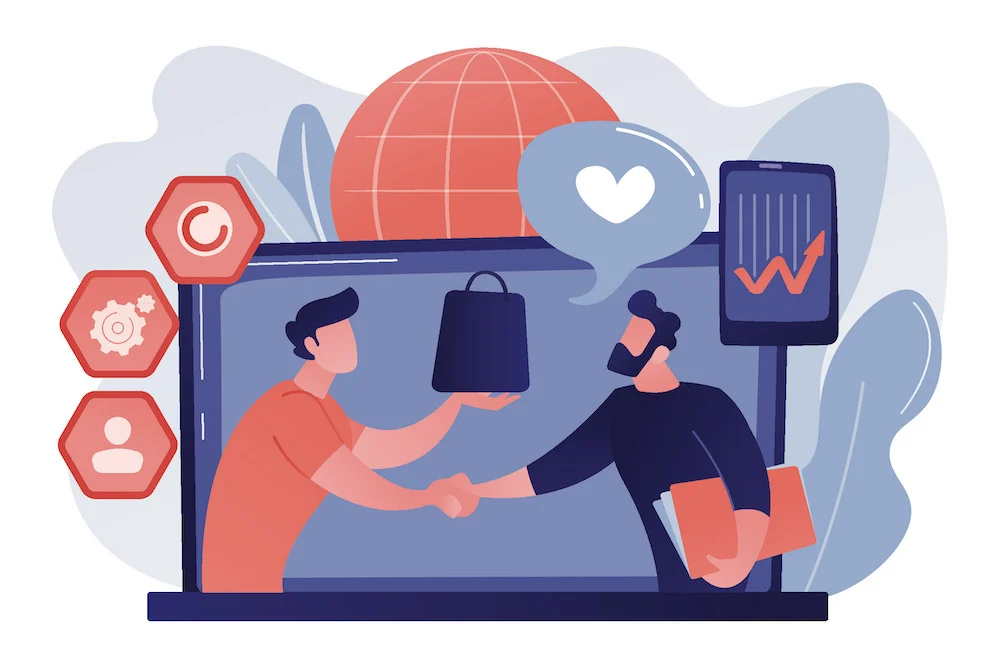In today’s fast-paced world, managing customer interactions and solving problems quickly is key to keeping your business ahead. But, finding the right tools to handle these challenges can be tough. Luckily, you’re in the right place!
Our blog dives into the top 9 problem-solving software examples designed to streamline your customer interaction management. With the right software, you can turn every customer challenge into an opportunity to shine.
Read on to discover how these tools can transform the way you deal with customer queries and problems, ensuring your business stays on the fast track to success.
The Evolution of Customer Service and Problem-Solving Software

The Shift Towards Digital Solutions
The digital transformation in customer service has been nothing short of a revolution. In the past, you’d have to wait on the phone for hours, listening to that insufferable hold music, just to speak to a customer service rep. Nowadays, digital solutions have streamlined these processes, making them more efficient and user-friendly. Here are a few examples:
- Online Chat Support: Websites now commonly feature live chat support, allowing customers to get immediate help. This has drastically reduced waiting times and improved customer satisfaction. Check out Zendesk Chat, a leading solution in this category.
- Self-Service Portals: Many businesses now offer self-service portals on their websites. These portals contain FAQs, troubleshooting guides, and forums where customers can solve problems on their own. Salesforce’s Self-Service Portal is a prime example.
- Social Media Customer Service: Brands are using social media platforms like Twitter and Facebook to provide quick customer support. This approach not only offers real-time interactions but also showcases the company’s commitment to customer service.
The Role of AI and Machine Learning
AI and machine learning have drastically upped the game in customer service problem-solving. These technologies can analyze vast amounts of data to predict customer behavior, personalize customer interactions, and automate responses. Here are a couple of ways they’re making a difference:
- Chatbots and Virtual Assistants: Powered by AI, chatbots can handle a multitude of customer queries simultaneously without breaking a sweat. Intercom and Drift provide AI-driven chat solutions that can engage customers 24/7.
- Predictive Customer Service: Machine learning algorithms can predict issues before they arise, allowing businesses to proactively address customer needs. This improves customer satisfaction and loyalty. Tools like Zendesk enable businesses to harness these predictive insights.
In essence, the integration of digital solutions, AI, and machine learning into customer service has transformed how businesses interact with their customers. It’s more efficient, more proactive, and definitely more in tune with what today’s tech-savvy consumers expect.
Understanding Problem Solving Software with Customer Interaction Management

What is Problem Solving Software?
At its core, problem solving software is designed to help businesses tackle issues head-on, making the process smoother and more efficient. This type of software often integrates various tools and features, such as:
- Automated Ticketing Systems: Automatically sorts and assigns customer issues to the appropriate team. Freshdesk is a prime example, helping businesses stay organized and responsive.
- Knowledge Bases: These are digital libraries of articles, guides, and FAQs that empower customers to find solutions on their own. Confluence by Atlassian is a popular choice for creating comprehensive, searchable knowledge bases.
The Importance of Customer Interaction Management
Customer Interaction Management (CIM) is all about creating meaningful connections with your customers at every touchpoint. A solid CIM platform does wonders for customer experience and satisfaction by:
- Personalizing Customer Interactions: Tailoring conversations and solutions based on the customer’s history and preferences. Salesforce CRM is renowned for its customer management capabilities, offering personalized experiences at scale.
- Streamlining Communication: Providing various channels (like chat, email, social media) for customers to reach out, making it easier for them to get the help they need when they need it.
Integrating Problem Solving and Customer Interaction
Combining problem-solving software with customer interaction management creates a powerhouse for customer service. This unified approach offers several benefits, including:
- Quicker Resolution Times: By having all the necessary information and tools in one place, customer service reps can resolve issues much faster.
- Increased Customer Satisfaction: Seamless integration means less hassle for customers. They get their problems solved quickly, and the personalized service makes them feel valued.
- Enhanced Efficiency: With everything integrated, companies can automate repetitive tasks, freeing up customer service reps to focus on more complex issues.
An excellent example of this integration is HubSpot’s Service Hub, which combines customer service software with a CRM to provide a complete view of the customer for personalized, efficient service.
In short, the marriage of problem-solving software with customer interaction management isn’t just smart; it’s essential for businesses looking to provide exceptional customer service in today’s digital age. Through this integration, companies can ensure a smooth, satisfying customer experience that keeps people coming back for more.
Top 9 Problem Solving Software Examples

Salesforce Sales Cloud
Key Features
- Customizable sales processes
- Comprehensive customer databases
- Advanced analytics and forecasting tools
How it Enhances Customer Interaction
Salesforce Sales Cloud turns every customer interaction into an opportunity by giving sales teams a 360-degree view of their customers. This means they can tailor their sales pitch to the customer’s specific needs and history, boosting satisfaction and the chances of closing the deal.
HubSpot
Key Features
- Inbound marketing tools
- Contact and deal management
- Email and marketing automation
How it Enhances Customer Interaction
HubSpot glues customer interactions across different channels into a single, streamlined narrative. By keeping track of every interaction, businesses can provide highly personalized service that makes customers feel understood and valued.
Zoho CRM
Key Features
- Process management
- Omnichannel communication
- AI-powered sales assistant
How it Enhances Customer Interaction
Zoho CRM is all about giving companies the tools to communicate with customers the way they prefer, whether that’s email, social media, or live chat. This flexibility enhances customer satisfaction, as they can choose the most convenient way to get in touch.
Pipedrive
Key Features
- Visual sales pipelines
- Activity reminders
- Mobile app access
How it Enhances Customer Interaction
Pipedrive helps sales teams focus on actions that matter most. With its visual interface, reps can easily track where a customer is in the sales process and identify the right moment for follow-up, ensuring no lead is left behind.
Omnex Systems
Key Features
- Integrated management systems
- Audit and inspection tools
- Compliance management
How it Enhances Customer Interaction
Omnex Systems focuses on the back-end of customer service—ensuring that businesses stay compliant and high-quality. While this might not directly interact with customers, it guarantees that services and products meet the standards customers expect, which in turn boosts satisfaction.
EngageBay
Key Features
- Marketing automation
- Helpdesk solutions
- CRM capabilities
How it Enhances Customer Interaction
EngageBay combines marketing, sales, and service software into a comprehensive package. This means businesses can keep their messaging consistent across all touchpoints, significantly improving the customer experience.
Hiver
Key Features
- Shared inboxes for team emails
- Email tags for organization
- Collision alerts to avoid duplicate responses
How it Enhances Customer Interaction
Hiver turns your standard Gmail account into a powerful customer service tool. By streamlining email communication within teams, it ensures that customer queries are answered promptly and efficiently, dramatically improving resolution times.
Help Scout
Key Features
- Shared customer profiles
- Beacon for in-app support
- Reporting and analytics
How it Enhances Customer Interaction
Help Scout is designed to make customer service more human and personal. Its tools help businesses treat customers as individuals, not just tickets, fostering a warmer, more personal connection that increases customer loyalty.
ProofHub
Key Features
- Project and task management
- Time tracking
- Custom reports
How it Enhances Customer Interaction
ProofHub ensures that delivering a project to a customer is as smooth and efficient as possible. Providing tools for better organization and communication guarantees that client work is completed on time and to spec, something every customer appreciates.
Implementing Problem Solving Software in Your Business

When you’re looking to level up your business with problem-solving software, it’s like deciding you need a Swiss Army knife for your business operations—it has to be just the right tool that fits your pocket and can address most of your needs. Here are some down-to-earth tips and insights into how to go about it.
Identifying Your Needs
Before you shell out cash or swipe that business card, it’s crucial to pinpoint what you actually need. Like, do you need a better way to track customer interactions, or is your team drowning in disorganized project timelines? Here’s how to figure it out:
- List down your pain points: Literally, write them down. Whether it’s slow customer service response times or tangled-up project management, getting these out on paper is step one.
- Talk to your team: Sometimes, the best insights come from the folks in the trenches. A quick chat over coffee or a formal meeting can unearth valuable nuggets of what’s needed most.
- Scout the competition: See what tools your competitors or industry leaders are leveraging. It’s not about copy-pasting their strategies but seeing what might also lift your game. Websites like Capterra or G2 can offersome keen insights.
Integration and Training
After picking out the perfect software, making it a seamless part of your daily grind is next. No one likes change, but with the right approach, your team might just thank you.
- Start with a demo: Most software providers give a demo or a trial period. Use it. It’s like test driving a car. You need to see how it feels and fits with your business operations.
- Create a rollout plan: Don’t just throw the software at your team and hope for the best. Plan a phase-wise integration. Start small, perhaps with a team or two, then expand.
- Invest in training: Set aside time and resources for training. Proper training is non-negotiable. Whether it’s webinars, one-on-one sessions, or even hiring an expert for a day or two, do it. Websites like LinkedIn Learning are gold mines for this.
Measuring Success
Finally, did that fancy new software actually do anything for you? Here’s how to tell:
- Set clear KPIs: What does success look like? More deals closed? Faster project delivery? Decide on key performance indicators (KPIs) early on.
- Use the software’s analytics tools: Most modern software comes loaded with analytics. Use them to track progress towards your KPIs.
- Regular check-ins with the team: Besides the numbers, the subjective feedback from your team is invaluable. If they’re happier and feel more productive, you’re probably on the right track.
Integrating new problem-solving software into your business isn’t just about making purchases and clicking install. It involves careful selection, thoughtful integration, and ongoing evaluation. But start right, and you’ll find your business operating smoother than ever, giving both your team and your customers plenty to smile about.
Future Trends in Problem Solving Software and Customer Interaction Management
The landscape of problem-solving software and how businesses manage their interactions with customers is rapidly evolving. Here are some key trends to watch out for, peppered with examples and a touch of plain English for easy understanding. We’ve also linked some key terms to deepen your insights.
Predictive Analytics and Personalization
The integration of Predictive Analytics in customer service isn’t just a fancy buzzword; it’s about making smarter decisions with data. Imagine logging into a streaming service like Netflix and seeing TV show recommendations tailored just for you. That’s Predictive Analytics at work, using your past behavior to personalize what you see next. This same concept is finding its way into problem-solving software, helping businesses anticipate customer needs and tailor responses more effectively.
The Rise of Omnichannel Support
Gone are the days when a phone call was the only way to reach customer support. Today, it’s all about Omnichannel Support, which sounds like a fancy term but simply means being where your customers are, whether that’s email, social media, live chat, or even text messaging. Take Zendesk, for example. It lets businesses manage customer conversations across all these channels from a single dashboard, ensuring a seamless experience no matter how the customer chooses to reach out.
Automation and Self-Service Options
Everyone loves a bit of DIY, right? The same goes for customer service, with more folks preferring to solve problems on their own before reaching out for help. That’s where Automation and Self-Service options come into play. From simple FAQ pages to sophisticated chatbots like those powered by Intercom, businesses are making it easier for customers to find answers quickly and on their own terms. It’s all about speeding up service and freeing up human agents for more complex queries.
In summary:
- Personalization is key, with businesses using data to tailor interactions to each customer’s needs.
- Omnichannel support ensures customers can connect through their preferred mediums, offering a unified customer experience.
- Automation and Self-Service empower customers to find solutions on their own, improving efficiency and customer satisfaction.
These trends point towards a future where technology not only makes problem-solving more efficient for businesses but also more personalized and accessible for customers.
FAQs
How Does AI in Customer Service Software Improve Problem Solving?
AI has dramatically transformed the landscape of customer service, making software solutions smarter and more efficient. By integrating AI, problem-solving software can now:
- Automate Responses: Instantly handle common queries without human intervention, freeing up time for agents to tackle complex issues.
- Predictive Analysis: Use past interactions and behavior to predict future issues or questions, enabling proactive problem solving.
- Personalize Interactions: Tailor responses based on customer history and preferences, enhancing satisfaction and engagement.
Can Problem Solving Software Integrate with Existing Business Tools?
One of the biggest concerns for businesses is whether new software will play nicely with their current ecosystem. The good news is, many leading problem-solving and customer interaction management solutions are designed with integration in mind. They often offer:
- APIs and Webhooks: These allow for seamless data exchange between different software platforms.
- Pre-built Integrations: Many solutions come with a library of integrations for popular CRM, email, and communication tools.
- Customization Options: Flexibility to tailor the software to fit unique business processes and toolsets.
What’s the ROI of Investing in Problem Solving Software?
Investing in problem-solving software with customer interaction management capabilities can yield significant returns, such as:
- Increased Efficiency: Automating routine tasks and streamlining problem-solving processes reduces operational costs.
- Improved Customer Satisfaction: Quick and personalized problem resolution enhances customer loyalty and retention.
- Data-Driven Insights: Understanding customer needs and behaviors through analytics can inform better business decisions and strategies.
How Important is Omnichannel Support in Problem Solving Software?
Omnichannel support has become a critical component of modern customer service, allowing businesses to provide a seamless experience across multiple platforms. Here’s why it’s vital:
- Consistency: Customers expect a uniform experience, whether they’re reaching out via social media, email, or phone.
- Accessibility: Being available on various channels means customers can choose their preferred method of communication.
- Engagement: Omnichannel support facilitates more meaningful interactions, building stronger relationships with your audience.
Are There Problem Solving Software Solutions Suitable for Small Businesses?
Absolutely! While some software may cater to larger enterprises, there are plenty of options designed with small businesses in mind. These solutions often offer:
- Scalability: Start with what you need and scale up as your business grows.
- Affordability: Many providers offer tiered pricing or even free versions to accommodate smaller budgets.
- Ease of Use: User-friendly interfaces and straightforward setup processes ensure small teams can get started without a steep learning curve.
Conclusion
In wrapping up, we’ve seen how the evolution of problem-solving software and customer interaction management is set to revolutionize the way businesses operate and engage with their customers. From harnessing predictive analytics for unparalleled personalization, adopting omnichannel support for seamless communication, to enabling customer empowerment through automation and self-service—each trend underscores a shift towards more efficient, responsive, and personalized customer experiences.
As these technologies continue to evolve, staying ahead means tapping into these advancements to foster stronger customer relationships and drive business growth.
LEARN MORE about how you can implement these strategies in your business

